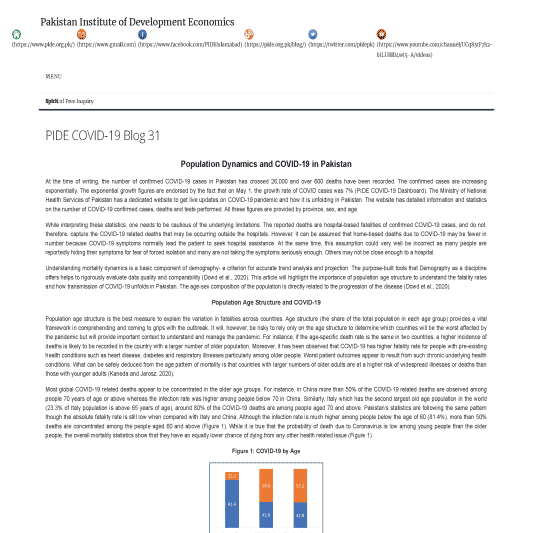
Pakistan Institute of Development Economics
- Home
Our Portals
MenuMenuMenuMenuMenuMenuMenu - ResearchMenuMenuMenuMenuMenuMenuMenu
- Discourse
- The PDR
- Our Researchers
- Academics
- Degree Verification
- Thesis Portal
- Our Portals
Population Dynamics and COVID-19 in Pakistan
At the time of writing, the number of confirmed COVID-19 cases in Pakistan has crossed 26,000 and over 600 deaths have been recorded. The confirmed cases are increasing exponentially. The exponential growth figures are endorsed by the fact that on May 1, the growth rate of COVID cases was 7% (PIDE COVID-19 Dashboard). The Ministry of National Health Services of Pakistan has a dedicated website to get live updates on COVID-19 pandemic and how it is unfolding in Pakistan. The website has detailed information and statistics on the number of COVID-19 confirmed cases, deaths and tests performed. All these figures are provided by province, sex, and age. While interpreting these statistics, one needs to be cautious of the underlying limitations. The reported deaths are hospital-based fatalities of confirmed COVID-19 cases, and do not, therefore, capture the COVID-19 related deaths that may be occurring outside the hospitals. However, it can be assumed that home-based deaths due to COVID-19 may be fewer in number because COVID-19 symptoms normally lead the patient to seek hospital assistance. At the same time, this assumption could very well be incorrect as many people are reportedly hiding their symptoms for fear of forced isolation and many are not taking the symptoms seriously enough. Others may not be close enough to a hospital. Understanding mortality dynamics is a basic component of demography- a criterion for accurate trend analysis and projection. The purpose-built tools that Demography as a discipline offers helps to rigorously evaluate data quality and comparability (Dowd et al., 2020). This article will highlight the importance of population age structure to understand the fatality rates and how transmission of COVID-19 unfolds in Pakistan. The age-sex composition of the population is directly related to the progression of the disease (Dowd et al., 2020).



